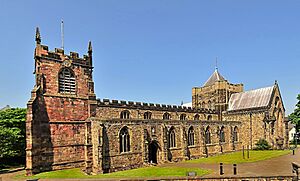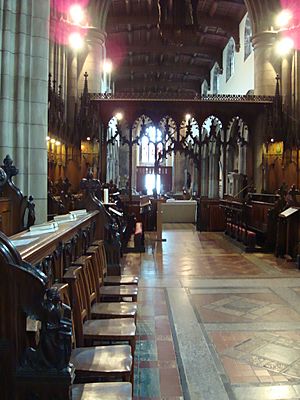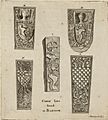Bangor Cathedral facts for kids
Quick facts for kids Bangor Cathedral |
|
|---|---|
| Saint Deiniol's Cathedral in Bangor | |
|
Cadeirlan Deiniol Sant ym Mangor
|
|

Bangor Cathedral
|
|
| 53°13′36″N 4°7′39″W / 53.22667°N 4.12750°W | |
| Location | Bangor, Gwynedd |
| Country | Wales |
| Denomination | Church in Wales |
| Previous denomination | Roman Catholic |
| History | |
| Founded | AD 525 |
| Founder(s) | Saint Deiniol |
| Dedicated | AD 525 |
| Consecrated | AD 546 |
| Past bishop(s) | Saint Deiniol - first Bishop of Bangor Thomas Herring — Bishop of Bangor and Archbishop of Canterbury and author of the "New Form of Common Prayer" Barry Morgan — Archbishop of Wales |
| Architecture | |
| Architect(s) | George Gilbert Scott |
| Style | Romanesque, Gothic |
| Administration | |
| Parish | Bro Deiniol |
| Archdeaconry | Bangor |
| Diocese | Bangor |
| Province | Wales |
Bangor Cathedral (called Eglwys Gadeiriol Bangor in Welsh) is a very old church in Bangor, Gwynedd, Wales. It is named after its founder, Saint Deiniol. People have worshipped on this spot since the 500s. The cathedral was built in a hidden spot. This might have been to keep it safe from Viking raiders who came from the sea long ago.
Contents
History of Bangor Cathedral
The story of Bangor Cathedral began around the year 530. This was when Saint Deiniol started a monastery here. The land was given by Maelgwn Gwynedd, who was the king of Gwynedd. Saint Deiniol is believed to have become the first Bishop of Bangor. The first monastery was attacked in 634 and again in 1073. None of the original buildings from that time are still standing.
Building the Cathedral
In 1102, people started working to rebuild Bangor Cathedral. The oldest parts of the current building were made between 1120 and 1139. This was with help from Gruffudd ap Cynan, another king of Gwynedd. He gave money and was buried near the main altar when he died in 1137. This early church was shaped like a cross and built in the Norman style. It was about 44 yards long. Gruffudd's son, Owain Gwynedd, was also buried here.
In 1211, the cathedral was badly damaged by King John's army. Later, in the 13th century, the church was made longer. It was damaged again in 1282 when King Edward I invaded Gwynedd. After this, a lot of rebuilding happened. The main part of the church, called the nave, was rebuilt in the late 1300s.
Later Changes and Repairs
Some people thought the cathedral was burned down in 1402 during a rebellion led by Owain Glyndŵr. However, there is no clear proof of this. But it was definitely rebuilt a lot from the late 1400s to 1532. A message above the tower door says that Bishop Skevington built the tower in 1532. More repairs and changes were made in the 1700s and 1800s.
Rowland Meyrick was the first Bishop of Bangor after the Reformation. He is buried under the cathedral. From July to September 2021, the cathedral was even used as a COVID-19 vaccination center. It also held church services that were spread out for safety.
Cathedral Architecture
The cathedral you see today looks the way it does because of a lot of work done by George Gilbert Scott. This work started in 1868. Scott had planned for a tall tower in the middle with a spire. But cracks appeared, which made people think the ground might be sinking. So, the tower was left as a low building. In 1879, more money was spent to fix up the main part of the church, the chapter house, and the central tower.
Interesting Features
Bangor Cathedral has some special things to see:
- The Mostyn Christ: This is a wooden carving from the late 1400s. It shows Jesus sitting on a rock, wearing a crown of thorns, before his crucifixion.
- The Biblical Garden: In the cathedral grounds, there is a garden with every type of plant mentioned in the Bible.
- Wooden Mice: The cathedral also has several wooden carvings made by Robert Thompson. He was famous for hiding tiny wooden mice in his work.
Important Burials
Many important people are buried at Bangor Cathedral. These include:
- Rowland Meyrick: He was a Welsh Bishop of Bangor from 1559 to 1566.
- Gruffydd ap Cynan: A King of Gwynedd, buried near the main altar.
- Owain Gwynedd: Another King of Gwynedd, first buried next to his father, Gruffydd ap Cynan. His burial place was later moved.
- Several other bishops of Bangor are also buried here, such as Nicholas Robinson (bishop) and Henry Rowlands (bishop).
The Cathedral Organ
The first mention of an organ in the cathedral is from a poem written between 1350 and 1370. It talks about a new instrument arriving. Everyone in the church helped pay for it.
During a time called the Commonwealth (1649–1660), the organ was taken away or destroyed. This was because of a rule to remove organs and other "superstitious monuments" from churches.
When King Charles II became king in 1660, a new organ was put in. It was paid for by a gift from Bishop William Roberts. The current organ was built in 1873 by William Hill, a famous organ builder. It has 4,210 pipes! This organ was rebuilt in 1954 and is used every day. Many students and famous organists from around the world have come to play it.
Between 2006 and 2008, the organ was rebuilt again. Its parts were moved around to make space for new facilities like toilets and a kitchen. The new control panel for the organ is now in the north part of the church.
Organists and Directors of Music
Many talented musicians have played the organ and led the music at Bangor Cathedral over the centuries. Some of the past organists include Joseph Pring and Roland Rogers. The role of "organist and master of the choristers" changed to "director of music" in 2014. The "assistant organist" role became "cathedral organist."
Languages Used
Bangor Cathedral holds services for both Welsh and English speakers. They have separate services for Holy Communion in each language. They also have bilingual services, like Choral Evensong, where both languages are used.
Images for kids
See also
- Bishop of Bangor
- Archdeacon of Bangor
- Archdeacon of Merioneth
- Archdeacon of Anglesey







